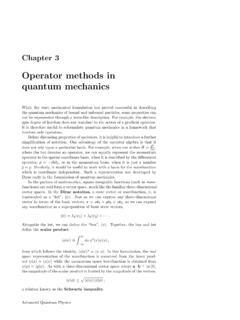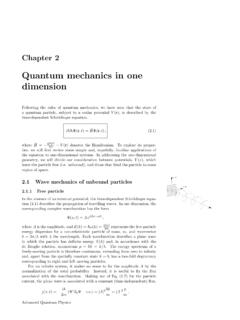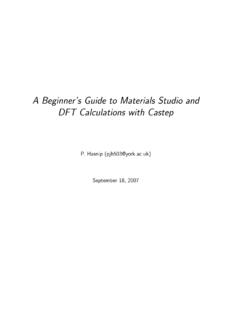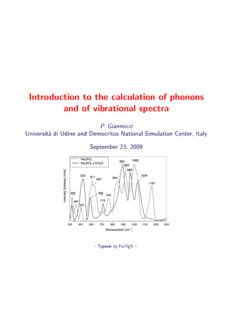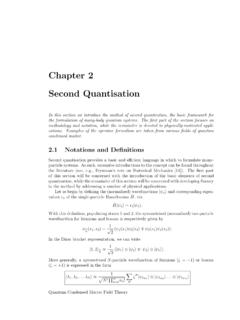Transcription of Lecture 6 Quantum mechanical spin - University of Cambridge
1 Lecture 6 Quantum mechanical spinBackgroundUntil now, we have focused on Quantum mechanics of particleswhich are featureless carrying no internal degrees of relativistic formulation of Quantum mechanics (due to Dirac andcovered later in course) reveals that Quantum particles can exhibitan intrinsic angular momentum component known as , the discovery of Quantum mechanical spin predates itstheoretical understanding, and appeared as a result of an ingeneousexperiment due to Stern and : outline1 Stern-Gerlach and the discovery of spin2 Spinors, spin operators, and Pauli matrices3 Spin precession in a magnetic field4 Paramagnetic resonance and NMRB ackground: expectations pre-Stern-GerlachPreviously, we have seen that an electron bound to a proton carriesan orbital magnetic moment, = e2me L B L/!
2 ,Hint= BFor the azimuthal component of the wavefunction,eim , to remainsingle-valued, we further require that the angular momentum!takes only integer values (recall that ! m !).When a beam of atoms are passed through an inhomogeneous (butaligned) magnetic field, where they experience a force,F= ( B)% z( zBz) ezwe expect a splitting into anodd integer(2!+1) number of experimentIn experiment, a beam of silver atoms were passed throughinhomogeneous magnetic field and collected on photographic silver involves spherically symmetric charge distribution plusone 5selectron, total angular momentum of ground state hasL= outer electron in 5pstate,L= 1 and the beam should split in experimentHowever, experiment showed a bifurcation of beam!
3 Gerlach s postcard, dated 8th February 1922, to Niels BohrSince orbital angular momentum can take only integer values, thisobservation suggests electron possesses an additional intrinsic !=1/2 component known mechanical spinLater, it was understood that elementary Quantum particles can bedivided into two classes, ( electron, proton, neutron) possess half-integer ( mesons, photon) possess integral spin (including zero).SpinorsSpace of angular momentum states for spins=1/2is two-dimensional:|s=1/2,ms=1/2 =| ,|1/2, 1/2 =| Generalspinorstate of spin can be written as linear combination, | + | =( ),| |2+| |2=1 Operators acting on spinors are 2 2 matrices. From definition ofspinor,z-component of spin represented as,Sz=12!
4 Z, z=(100 1) eigenvalues !/2 corresponding to(10)and(01).Spin operators and Pauli matricesFrom general formulae for raising/lowering operators, J+|j,m = j(j+ 1) m(m+ 1)!|j,m+1 , J |j,m = j(j+ 1) m(m 1)!|j,m 1 withS =Sx iSyands=1/2, we haveS+|1/2, 1/2 =!|1/2,1/2 ,S |1/2,1/2 =!|1/2, 1/2 , in matrix form,Sx+iSy=S+=!(0100),Sx iSy=S =!(0010).Leads toPauli matrixrepresentation for spin 1/2,S=12! x=(0110), y=(0 ii0), z=(100 1)Pauli matrices x=(0110), y=(0 ii0), z=(100 1)Pauli spin matrices are Hermitian, traceless, and obey definingrelations (cf. general angular momentum operators): 2i=I,[ i, j]=2i&ijk kTotal spinS2=14!2 2=14!2 i 2i=34!2I=12(12+ 1)! (s+ 1)!2, as expected for spins=1 degrees of freedom and spinSpin represents additional internal degree of freedom, independentof spatial degrees of freedom, [ S,x]=[ S, p]=[ S, L] = state is constructed fromdirect product,| = d3x( +(x)|x | + (x)|x | ) (| + | )In a weak magnetic field, the electron Hamiltonian can then bewritten as H= p22m+V(r)+ B( L/!)
5 + ) BRelating spinor to spin directionFor a general state | + | , how do , relate toorientation of spin?Let us assume that spin is pointing along the unit vector n= (sin cos ,sin sin ,cos ), in direction ( , ).Spin must be eigenstate of n with eigenvalue unity, (nznx inynx+iny nz)( )=( )With normalization,| |2+| |2= 1, (up to arbitrary phase),( )=(e i /2cos( /2)ei /2sin( /2))Spin symmetry( )=(e i /2cos( /2)ei /2sin( /2))Note that under 2 rotation,( )+ ( )In order to make a transformation that returns spin to startingpoint, necessary to make two complete revolutions, (cf. spin 1which requires 2 and spin 2 which requires only !).(Classical) spin precession in a magnetic fieldConsider magnetized object spinning about centre of mass, with angularmomentumLand magnetic moment = Lwith gyromagnetic magnetic fieldBwill then impose a torqueT= B= L B= tLWithB=B ez, andL+=Lx+iLy, tL+= i BL+,with the solutionL+=L0+e i Btwhile tLz= momentum vectorLprecesses about magnetic fielddirection with angular velocity 0= B(independent of angle).
6 We will now show that precisely the same result appears in the studyof the Quantum mechanics of an electron spin in a magnetic field.( Quantum ) spin precession in a magnetic fieldLast Lecture , we saw that the electron had a magnetic moment, orbit= e2me L, due to orbital degrees of intrinsic electron spin imparts an additional contribution, spin= S, where thegyromagnetic ratio, = ge2meandg(known as theLand eg-factor) is very close to components combine to give the total magnetic moment, = e2me( L+g S)In a magnetic field, the interaction of the dipole moment is given by Hint= B( Quantum ) spin precession in a magnetic fieldFocusing on the spin contribution alone, Hint= S B= 2! BThe spin dynamics can then be inferred from the time-evolutionoperator,| (t) = U(t)| (0) , where U(t)=e i Hintt/!
7 = exp[i2 Bt]However, we have seen that the operator U( ) = exp[ i! en L]generates spatial rotations by an angle about the same way, U(t) effects a spin rotation by an angle Btabout the direction ofB!( Quantum ) spin precession in a magnetic field U(t)=e i Hintt/!= exp[i2 Bt]Therefore, for initial spin configuration,( )=(e i /2cos( /2)ei /2sin( /2))WithB=B ez, U(t) = exp[i2 Bt z],| (t) = U(t)| (0) ,( (t) (t))=(e i2 0t00ei2 0t)( )=(e i2( + 0t)cos( /2)ei2( + 0t)sin( /2)) spin precesses with angular frequency 0= B= g c ez,where c=eB2meiscyclotron frequency,( cB%1011rad s 1T 1).Paramagnetic resonanceThis result shows that spin precessionfrequency is independent of spin a frame of reference which is itselfrotating with angular velocity about we impose a magnetic fieldB0=B0 ez, in the rotating frame, theobserved precession frequency is r= (B0+ / ), aneffective fieldBr=B0+ / acts in rotating frame rotates exactly at precession frequency, = 0= B0,spins pointing in any direction will remain at rest in that we now add a small additional component of the magneticfield which is rotating with angular frequency in thexyplane,B=B0 ez+B1( excos( t) eysin( t))Paramagnetic resonanceB=B0 ez+B1( excos( t) eysin( t))
8 Effective magnetic field in a frame rotating with same frequency as the small added field isBr=(B0+ / ) ez+B1 exIf we tune so that it exactly matches the precession frequency inthe original magnetic field, = 0= B0, in the rotating frame,the magnetic moment will only see the small field in will therefore precess aboutx-direction at slow angularfrequency B1 matching of small field rotation frequency withlarge field spin precession frequency is resonance .Nuclear magnetic resonanceThe general principles exemplified by paramagnetic resonanceunderpin methodology ofNuclear magnetic resonance (NMR).NMR principally used to determine structure of molecules inchemistry and biology, and for studying condensed matter in solid orliquid relies on nuclear magnetic moment of atomic nucleus, = for proton =gPe2mpwheregp= magnetic resonanceIn uniform field,B0, nuclear spins occupyequilibrium thermal distibution withP P = exp[!]
9 0kBT], 0= (typically small) population of additional oscillating resonant in-plane magnetic fieldB1(t) for a time,t, such that 1t= 2, 1= B1( /2 pulse ) orients majority spin in xy-plane where it precesses atresonant frequency allowing a coil to detect signal from to equilibrium set by transverse relaxation time, magnetic resonanceResonance frequency depends onnucleus (through ) and is slightlymodified by environment! resonance imaging (MRI), focus is onproton in water and fats. By using non-uniform field,B0, resonance frequency can be made positiondependent allows spatial structures to be : Quantum mechanical spinIn addition to orbital angular momentum, L, Quantum particlespossess an intrinsic angular momentum known as spin, fermions, spin is half-integer while, for bosons, it is of electron expressed as a two-component spinor,| = d3x( +(x)|x | + (x)|x | ) (| + | )In a weak magnetic field, H= p22m+V(r)+ B( L/!)
10 +g2 ) BSpin precession in a uniform field provides basis of paramagneticresonance and NMR.
